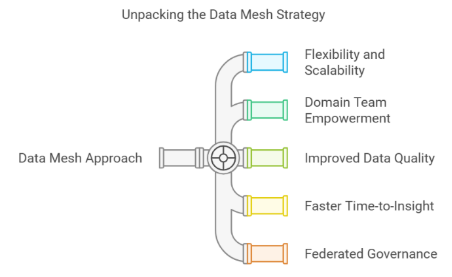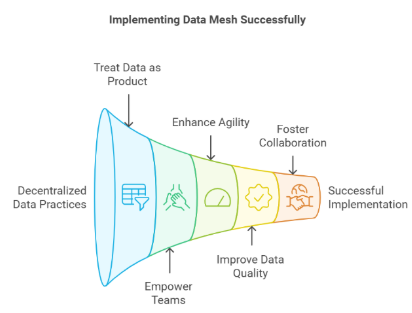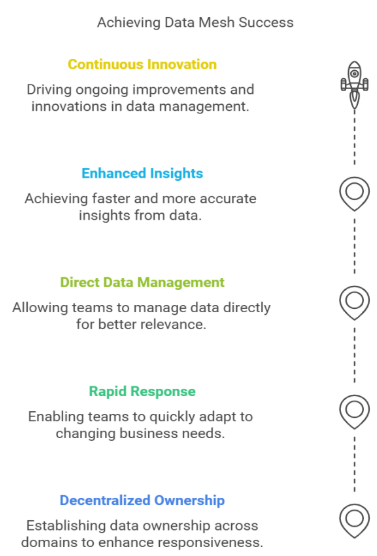Data is one of the most valuable assets for any organization and should be managed with the same care as a product—featuring clear interfaces, thorough documentation, and seamless usability for downstream consumers. Traditionally, organizations have leaned on data architectures built around databases and data warehouses. These systems are highly structured, optimized for storing and analysing transactional data in a predictable, organized manner. Data was neatly arranged in tables with predefined relationships, enabling efficient processing but often at the cost of flexibility.

Many enterprises adopted approaches like Enterprise Data Warehouses (EDW), Data Marts, and Data Lakes to meet their daily analytics needs. These approaches involve sourcing, aggregating, and storing data, including unstructured data, and performing analytics on it. However, traditional architectures tend to centralize control over data, limiting accessibility and making it challenging for diverse teams to utilize data independently.
As data complexity increased, it became evident that traditional architectures couldn’t keep pace with modern needs. The growing scale, complexity, and diversity of data in contemporary enterprises necessitated more flexible and scalable architectures, with greater responsibility placed on stakeholders for managing and utilizing data effectively.
Challenges with traditional architectures
Enterprises are increasingly analysing unstructured data, such as social media posts, IoT device outputs, cloud applications, APIs, weblogs, and sensor logs. Integrating siloed data across departments and Data Warehouse (DWH) environments has always been a challenge due to rigid structures and issues with scalability, maintenance, efficiency, and cost, particularly as organizations grow and data volumes rapidly increase.

Data pipelines managed by a single central team often lead to delays, poor scalability, and dependency issues. Innovation and responsiveness to business needs frequently remain points of contention. Centralized models struggle to scale cost-effectively and handle the heterogeneity of modern data ecosystems.
Governance within centralized models is often cumbersome, with central ownership making the process bureaucratic and complicating business data access.
Essentials of a Business-Oriented Organization
In the new digital economy, modern businesses require real-time or near-real-time insights to stay competitive. Business domains often depend on data teams for analyzing data to gain insights, which can lead to delays and mismatches in understanding requirements.

Moving towards decentralized data management approaches can help address these challenges, enabling faster, more efficient, and more accurate data-driven decision-making.
Data Mesh an agile enterprise approach
Decentralizing data ownership to domain experts ensures that data is more aligned with business goals and is more usable by those who understand it best. This approach provides teams with access to standardized, scalable tools for ingesting, processing, and serving data without heavily relying on centralized teams. Uniformly applied governance policies across domains ensure consistency, compliance, and security.
Introduction to Data Mesh

The Data Mesh approach is ideal for organizations with diverse business units like retail, logistics, and finance. By decentralizing data ownership, it ensures that teams closest to the data generate and manage it, breaking down silos.
This modern architecture supports structured and unstructured data through a decentralized, domain-oriented model, empowering domain teams to take full responsibility for their data. This approach enhances scalability, agility, and accountability while reducing bottlenecks in analytics and decision-making.
Domain teams gain autonomy to adapt systems, ensuring faster insights and high-quality data products. Federated governance balances standardization and flexibility, enabling compliance and interoperability.
Data Mesh accelerates AI/ML initiatives and supports multi-cloud and hybrid systems by delivering fresh, reliable, domain-specific data, driving innovation and efficiency. Decentralized ownership empowers teams to experiment, innovate, and maintain high standards, aligning with modern cloud architectures for seamless data management.
Considerations for a Data Mesh
Data Mesh is a paradigm shift it introduces in data architecture, governance, and organizational culture. Decentralization risks recreating silos if domains fail to adhere to interoperability standards. Data Mesh implementations take time to deliver measurable benefits due to the required cultural, technical, and process changes.
Organization must evaluate its cultural readiness, technical maturity, and willingness to invest in the required infrastructure. Transitioning to Data Mesh can be disruptive, and without proper alignment, it might lead to fragmented data silos.

Transitioning to a decentralized model requires a cultural shift where domain teams take ownership of their data. This can be difficult in organizations accustomed to centralized control. Resistance from teams unwilling or unprepared to take on additional responsibilities, leading to lack of engagement or poor implementation.
Domain teams need technical expertise in data engineering, governance, and analytics to manage data effectively. Without it, poor data quality and mismanagement can occur.
While Data Mesh offers numerous benefits, it also presents challenges:
- Risk of Silos: Decentralization can create new silos if interoperability standards aren’t followed.
- Implementation Time: Requires significant cultural, technical, and process changes, delaying benefits.
- Cultural Readiness: Organizations must assess their readiness and invest in infrastructure to avoid fragmentation.
- Cultural Shift: Adopting a decentralized model requires domain teams to take ownership, which can be difficult for those accustomed to centralized control.
- Resistance: Some teams may resist added responsibilities, leading to poor engagement.
Proper planning and investment in skills and infrastructure are essential to realize the full potential of Data Mesh.
Mitigating risk
Absolutely, these are excellent steps for successfully transitioning to a Data Mesh. Here’s a detailed approach:
| Conduct Training and Workshops | Goal: Promote data ownership and accountability among domain teams.
Action: Organize training sessions and workshops to educate teams on the importance of data ownership, best practices, and their roles in the new Data Mesh architecture. |
| Establish Federated Governance | Goal: Promote data ownership and accountability among domain teams.
Action: Organize training sessions and workshops to educate teams on the importance of data ownership, best practices, and their roles in the new Data Mesh architecture. |
| Create a Temporary Centralized Team | Goal: Facilitate a smooth transition to Data Mesh.
Action: Set up a temporary centralized team to oversee and guide the implementation process. This team can provide support, resolve issues, and ensure adherence to governance standards. |
| Define Clear Data Schemas, APIs, and Formats | Goal: Ensure seamless integration and interoperability across domains.
Action: Develop and document standard data schemas, APIs, and data formats that all domains must follow. This will ensure data consistency and facilitate easier data sharing and integration. |
| Incremental Implementation | Goal: Manage the transition effectively and minimize risks.
Action: Start by implementing Data Mesh in a few selected domains. Learn from this initial phase, refine processes, and gradually scale the implementation organization-wide. |
| Invest in Upskilling Domain Teams | Goal: Equip domain teams with the necessary skills to manage and utilize their data.
Action: Provide training in data engineering, governance, and analytics. Upskilling domain teams will empower them to handle their data effectively and create high-quality data products. |
In summary, while Data Mesh offers significant advantages, organizations must carefully plan and prepare for these changes to successfully transition and realize the potential benefits. With decentralized data ownership, domain teams can respond more quickly to changing business needs without waiting for centralized approval, leading to faster time-to-insight.

Domain teams, who have the deepest understanding of their data, can directly manage and utilize it, ensuring more relevant and accurate data products. Data Mesh a compelling choice for modern organizations seeking to enhance their data management capabilities and drive continuous innovation.
Author: Zaheer Ahmed Khan,
Principal Architect & CSM – Analytics EMEA, Edgematics


